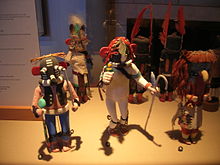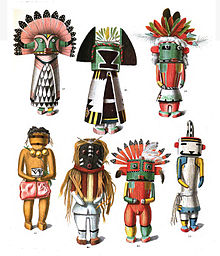Kachina
In the cultures of the Hopi , Zuni and other Pueblo Indians in the southwest of the United States, Kachina , Katchina or Katsina denotes three appearances: the spirit of a natural phenomenon in the form of an animal, a plant, an ancestor, etc., the masked dancer who has this spirit represents, and the figurative representation of the same. The spelling Katsina comes from the Hopi language. The plural katsinam only applies to the spirits and the dancers, because the plural suffix -m is reserved for living beings. Katsinam act as a mediator of people's prayers to the gods for the rain that is important in this region. For this reason, they are considered to be higher beings.
Shapes and figures
The clowns (Tsutskut) play their own role . They can appear on all occasions and entertain with rough jokes and criticism of the behavior of individual villagers. The most famous clown is the "Mud Head " Koyemsi , who was adopted by the Zuni . The carved figure is called Tihu ( plural Tithu ). Tithu are called Kachina Dolls (Kachina dolls) in literature . They are distributed to the children on special occasions to familiarize them with the appearance and nature of the Katsinam . The figures are hung in the house, the simple versions are also used as toys. The number of Hopi katsinam and clowns cannot be specified precisely because old figures keep disappearing and new ones being introduced. Frederick J. Dockstader gives in his book The Kachina and the White Man the number with "a little more than 400". For some katsinam there is only the name in the literature.
The Zuni are called dancers and figures Kokko . Little is known of the dancers and figures from the villages further to the east ( Acoma and Pueblos in the valley of the Rio Grande ), as they were heavily exposed to the missionary pressure of the Spaniards; therefore, their inhabitants held and still keep their religious celebrations in secret.
Commercialization
From around 1900 there was great interest in the Kachina figures , especially among white tourists , and the dolls became coveted collector's items . Because of this, many Hopi began making the figurines commercially in order to make a living. The grandfather and an uncle of the Hopi artist Dan Namingha are also known as carvers of Kachina figures.
Today, the manufacture is considered a high form of carving, and the Kachina dolls are priced between $ 500 and $ 10,000 in the Native American art market. The older figures are particularly popular in France. The highest prices in 1997 and 2006 were achieved by “Salako Mana” figures, which were auctioned for around 270,000 US dollars each at Sotheby’s in New York City , among others .
Collections

The most famous collections of Kachina figurines are in the Heard Museum in Phoenix and the Southwest Museum in Los Angeles . Other collections can be found in the Museum of Northern Arizona in Flagstaff , the Field Museum in Chicago , the American Museum of Natural History in New York City and the Museum of Anthropology in Columbia, Missouri . As early as 1901, the collection of these dolls began in the Berlin Ethnological Museum . Artists such as Horst Antes , Piero Dorazio , Marcel Duchamp , Max Ernst , André Malraux and Emil Nolde also collected and painted Kachina figures.
Individual evidence
- ↑ Hopi Dictionary Hopìikwa Lavàytutuveni The University of Arizon Press, 1998, p. 217
- ^ Mariko N. Walter, Eva Jane Neumann Fridman: Shamanism: An Encyclopedia of World Beliefs, Practices and Culture . ABC-CLIO, 2004, ISBN 1-57607-645-8 , pp. 347-348.
- ↑ Hodge: The Kachinas are coming , Northland Press, 1936, pages XV / XVI
- ↑ Fewkes: "Hopi Katcinas, drawn by native artists, Rio Grande Press Inc., 1979, pp 161ff
- ^ Dockstader: The Kachina and the White Man , University of New Mexico Press, 1985, p. 23
- ↑ Handbook of North American Indians , Vol. 9, Smithsonian Institution, 1979, p. 500
- ^ Schaaf: Hopi Katsina , 1600 Artist Biographies, CIAC Press, 2008
- ↑ Werner Götz: Dan Namingha, important Indian artist, can be seen in Landshut from May 24th. In: rundschau24.de. Accessed December 31, 2014 .
- ↑ Eric Bromberg: The Hopi Approach to the Art of Kachina Doll Carving . P. 18
- ↑ ARTNET AUCTION REPORT: SOTHEBY'S AMERICAN INDIAN ART. In: artnet.com. July 31, 2006, accessed December 31, 2014 .
- ↑ Geneste & Mickeler Kachina Messagers des dieux Hopi et Zuni , SOMOGY éditins d'art, 2011, page 22
- ↑ Harry C. James: The Hopi Indians, Their History and their Culture. P. 173
- ↑ Katsinam, Figures of the Pueblo Indians of North America from the study collection Horst Antes , Völkerkundemuseum Lübeck, 2000
- ↑ Marcus Kenzler: The view into the other world. LIT Verlag Münster, 2012, ISBN 9783643110251 , p. 499. Restricted preview in the Google book search


